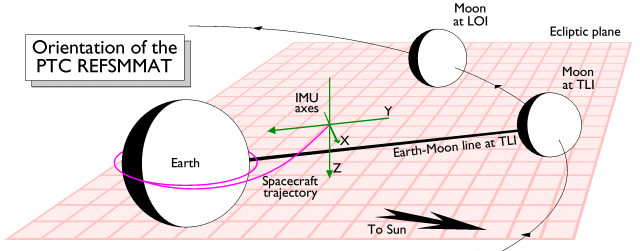You're correct that the spacecraft was already on the right course, but on the way to the moon, the CSM/LM stack would make several attitude changes for various purposes.
The spacecraft would spend most of the flight aligned roughly perpendicular to its flight path, in a north-south orientation, spinning slowly on its axis to evenly distribute heat from sunlight; this is called the Passive Thermal Control (PTC) roll or informally the "barbecue roll".
In this attitude, Earth and the Moon would alternate being visible through either the CM or LM windows.
The guidance platform has a few different reference orientations programmed into it, called REFSMMATs, and after trans-Earth injection, they switch from the "launch orientation" REFSMMAT to the "PTC orientation" REFSMMAT. The orientation of the spacecraft is considered relative to one of these orientations.
From the Apollo 15 annotated flight journal, here's how the PTC orientation system is defined (bold mine):
The platform's X-axis is aligned along the ecliptic plane, perpendicular to the line between the Earth and Moon at the time of Trans-Earth Injection (TEI). Its Z-axis is aligned perpendicular to the ecliptic plane, directed southward. This alignment is used for all translunar and trans-Earth coast maneuvers and as the reference for easy alignment of the PTC (Passive Thermal Control) maneuver. Note that the axes shown do not represent the orientation of the spacecraft during PTC, only that of the [guidance] platform.

At 11:44:58 in the transcript, they're starting to maneuver into the PTC attitude and we have this annotation:
[The PTC maneuver requires the spacecraft to be rotated around the X, or longitudinal axis, in a slow roll of 0.35° per second. A complete roll of 360° should take about 17 minutes at that speed.]
[The X-axis of the CSM is an imaginary line which runs from the centre of the SPS engine bell, through the centre of the SM and out through the apex of the CM's cone. Incidentally, in the docked configuration, the LM's X-axis is colinear with the CSM's but is in the opposite direction, running from the descent engine to the docking hatch and, because of this, the Y- and Z-axes of each spacecraft are also opposed. The 'front doors' of each spacecraft are aligned 60° around the X-axis from each other. Readers should be careful to distinguish between the spacecraft axes and those of the IMU.]
[The last P52 aligned the X-axis of the IMU platform with the ecliptic and at right angles to the Earth-Moon line; its Z-axis was aligned southward, perpendicular to the ecliptic. If the spacecraft were aligned to match the platform, it would have its longitudinal axis aligned with the ecliptic with the Earth and Moon to either side. By pitching 90°, as called for in the Flight Plan, the longitudinal axis of the spacecraft is brought perpendicular to the ecliptic which guarantees that the Sun (which is always in the plane of the ecliptic) will strike the spacecraft side on as it rotates.]
Looking at the image, if you take the X-axis of the spacecraft, and pitch it up (or down) 90 degrees from the IMU X-axis you wind up with the spacecraft aligned north-south, with the sun hitting it on the side, so the roll gets all sides of the craft evenly roasted.
The PTC roll was stopped and the spacecraft reoriented to take star sightings along the way, as well as to do short course correction burns.
The next major firing of the CSM engine would be to slow down on the far side of the moon to slow down into lunar orbit. This would be done "pointing backwards", with the engine bell facing in the direction of motion.


